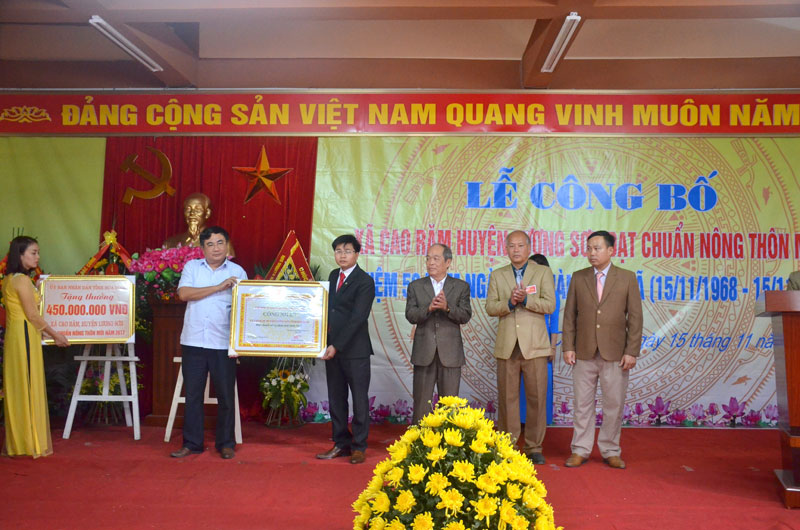
(HBO)- A ceremony was held in Cao Ram commune, Luong Son district on November 15 to welcome the new-style rural area title and mark the 50th founding anniversary of the commune.
After 50 years of construction and development, the commune has
seen significant advancements in economic structure shifting as well as
improvements in infrastructure, culture-education, social order, and local
livelihood. Those serve as a basis for Cao Ram commune to fulfill all of the 19
criteria on building new style rural area.

Photo: Leading official of the provincial
Department of Agriculture and Rural Development presents certificate recognising
Cao Ram commune as a new-style rural area.
During 2011-2017, nearly 90 billion VND was mobilized for the
new-style rural area bulding programme, over 11.9 million VND of which was
contributed by local people. This helps create a facelift to the locality, with
modern infrastructure, robust achievement in agricultural sector, and stable
social security. The average annual per capita income in 2011 was recorded at
10 million VND, and the figure rose to 26.2 million VND in 2017.
Due attention has been paid to poverty alleviation, bringing it down to only
5.3 percent in 2017. More than 95 percent of the households have accessed to
clean water and 65 percent of the local families have hygienic latrines.
Particularly, the local administration has given overriding priority to Party
building and political consolidation.
The provincial People’s Committee presented a certificate recognising Cao Ram
as a new-style rural area and presented the commune a social welfare facility
worth 450 million VND.
On the occasion, Luong Son district People’s Committee presented certificates
of merit to 10 organisations and 15 individuals with excellent performance in
building Cao Ram commune into a new-style rural area in 2017./.
The Standing Board of the Hoa Binh provincial Party Committee has agreed in principle on a proposal by the Standing Board of the Party Committee of Hoa Binh city to gather feedback on the city’s 1:2000 zoning plan, which forms part of its broader urban development strategy.
Hoa Binh province has made notable progress in public administration reform and digital government development, with the satisfaction index among citizens and businesses reaching over 84%, according to recent government evaluations.
Thanks to great efforts by local authorities in recent times, the governance and public administration performance of Mai Chau district has been significantly improved.
In the afternoon of June 6, the Party Committee, the People's Council, the People's Committee and the Fatherland Front of Lac Son district solemnly held a meeting to celebrate the 139th anniversary of the district's founding (1886–2025) and the 79th anniversary of the establishment of the district's Party Committee (1946–2025). There was the attendance of Mr. Bui Van Thang, the Vice Chairman of the Provincial People's Council; Mr. Quach Tat Liem, the Vice Chairman of the Provincial People's Committee; Ms. Dang Bich Ngoc, the Deputy Head of the National Assembly Delegation of the province; as well as the former leaders of the province and district through various periods, who are the natives of the district.
Implementing the Politburo’s Resolution No. 57-NQ/TW on breakthroughs in science – technology, innovation, and digital transformation is a golden opportunity for the northern mountainous province of Hoa Binh to renew growth model, improve competitive edge and shorten digital gap.
Resolution 57-NQ/TW, issued by the Politburo on December 22, 2024, identifies sci-tech, innovation, and digital transformation as strategic breakthroughs to build a developed and prosperous nation. In Hoa Binh province, this spirit is not just a slogan, it’s being put into action through concrete initiatives that form a "new development triangle”: digital citizenship, digital economy, and digital administration.



